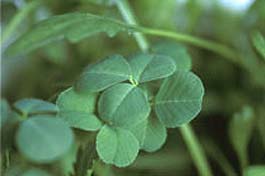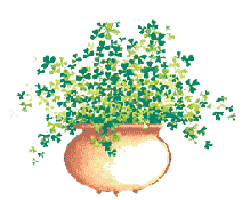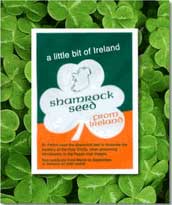| |

Traditions, folklore, history and more. If it's Irish, it's here. Or will be!
"People will not look forward to posterity who never look backward to their ancestors."
-Edmund Burke




Quotes
Library: Books, Movies, Music
Prints & Photos
Poetry
Jokes


Shops Ireland
Bunús na Gaeilge
(Basic Irish)
Circle of Prayer
Blessings
Did You Know?
Himself/Herself
Write to Us
Readers Write..
Links/Link to Us
Advertise with us
Awards & Testimonials
Submissions Guide


|
|
|
Emblems of Ireland: The Shamrock
by Bridget Haggerty
 According to the Concise Columbia Encyclopedia, the identity of the true shamrock has long been debated, but the plants most often designated as the emblem of Ireland are the white clover, the small hop clover, and the wood sorrel, or oxalis. According to the Concise Columbia Encyclopedia, the identity of the true shamrock has long been debated, but the plants most often designated as the emblem of Ireland are the white clover, the small hop clover, and the wood sorrel, or oxalis.
It's likely that some or all of this information was provided by the botanist, Nathaniel Colgan, who endeavored to identify "the real shamrock" at the turn of the 20th century.
He asked people all over Ireland to send him living, rooted specimens which he carefully planted and labelled. When the plants matured and blossomed, he was able to identify four different plants - the three already mentioned and one called Black Medick.
So how did the shamrock become an emblem of Ireland? It may surprise many readers to learn that the plant's international association with the Emerald Isle is relatively recent.
It wasn't until the 17th century that it became the custom to wear the shamrock on the feast of Ireland's patron saint; until then, the Irish wore a special St. Patrick's cross, made just for the occasion. Then, in the late 18th century, the shamrock was adopted as an emblem by the Volunteers of 1777. But it didn't really become widely popular until the 19th century, when the emerging Nationalist movements took the shamrock, along with the harp, as one of their emblems.
Viewed as an act of rebellion in Victorian England, Irish regiments were forbidden to display it. This one single act may have done more to establish the shamrock as Ireland's national emblem than anything else. It was also the catalyst for the creation of the famous ballad, The Wearin' O' The Green:
"Oh Paddy dear, and did ye hear the news that's going round?
The shamrock is forbid by law to grow on Irish ground!
No more St. Patrick's Day we'll keep; his color can't be seen,
For there's a cruel law agin' the wearing o' the Green!"
 While the lyrics may have stirred the souls and hearts of rebellious Irishmen, there are a couple of strange contradictions in this verse: it's very likely that St. Patrick wore vestments of blue, not green; and since the plant wasn't cultivated but grew wild, there was no way the Crown could have successfully banned its growth! While the lyrics may have stirred the souls and hearts of rebellious Irishmen, there are a couple of strange contradictions in this verse: it's very likely that St. Patrick wore vestments of blue, not green; and since the plant wasn't cultivated but grew wild, there was no way the Crown could have successfully banned its growth!
As for St. Patrick using it to teach us the mystery of the Holy Trinity, it was never mentioned in any of his writings. So, that of itself, remains a mystery. On the other hand, Triads, or groups of three, were of major significance in ancient Ireland; so it is quite possible that the shamrock may have been used by early Christian teachers because, not only could it instantly illustrate and explain an important belief, it would also have been symbolically acceptable.
But that was then.
Today, the shamrock is firmly established as the most instantly recognizable emblem of Ireland. For good luck, it's usually included in the bouquet of an Irish bride, and also in the boutonniere of the groom. It's the symbol of a quality B & B that's earned the right to display it. It's part of the Aer Lingus logo, as well as those of many other companies, sports teams and organizations. And, it's also an integral part of an old tradition called "drowning the shamrock."
This takes place on St. Patrick's Day, when the shamrock that has been worn in the hat or lapel is removed and put into the last drink of the evening. A toast is proposed and then, when the toast has been honored, the shamrock is taken from the bottom of the glass and thrown over the left shoulder. Sláinte!
Genuine Shamrock Seeds
Note: There is a common belief that Shamrock is a very difficult plant to grow, especially outside the environs of Ireland. While there is undoubtedly some truth in this, if you are careful, Shamrocks are a pretty easy plant to grow. They thrive in warm to cool air, fairly moist soil, and in a sunny spot (when they are flowering). Try not to place them in a south window and don't let them get too hot, never over 75 degrees.
Sow outdoors from March to September. Sow indoors all year round. When planted in early January you should have good-sized plants by Saint Patricks Day.
 Because Shamrocks are bulbs, they are best planted close to the surface in a peat-based potting soil. A once per month feeding with a liquid plant fertilizer will do the trick. Because Shamrocks are bulbs, they are best planted close to the surface in a peat-based potting soil. A once per month feeding with a liquid plant fertilizer will do the trick.
They grow tired now and again and begin to look a bit droopy, or even a bit dead; with the leaves turning brown. It's just time for good rest. Stop watering, relocate them to a darker place while the dormant period lasts. Usually occurring a few times each year lasting 2-3 months.
A good time to re-pot them would be after they've been dormant for the 2-3 months.
Remember, shamrocks do not get along with other houseplants in mixed pots. They are best grown with just other shamrocks all together in a crowded pot.
To order, please click here: Shamrock Seeds.
(Thanks to Lollysmith for the Shamrock growing instructions.)
Photo Credit: The stunning image of shamrocks was taken by Jim Crotty, a professional commercial and fine arts photographer. The photo is available for sale. Please click Shamrock Print
|
|
Fri, Sep 27, 2024
 The Galway Hooker The Galway Hooker
This unique vessel, with its distinctive curved lines and bright red sails, originated in the village of Claddagh. During the 19th century, hookers supported a significant fishing industry and also carried goods, livestock and fuel. Seán Rainey is remembered for building the last of the original boats, the Truelight, for Martin Oliver who was to become the last king of the Claddagh; as king, he was entitled to white sails on his boat. Since the mid seventies, many of the old sailing craft which were on the verge of extinction have been lovingly restored and new ones have been built. During the summer months they can be seen at festivals such a Cruinniú na mBád - the Gathering of the Boats - in Kinvara.
Click for More Culture Corner.
|
|




 The Galway Hooker
The Galway Hooker